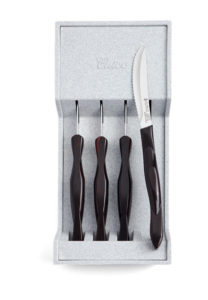
Welcome to the Chef’s Guide To The Best Knives! As an aspiring or seasoned chef, you know the importance of having the right tools in your kitchen, and knives are undoubtedly the most essential ones. In this comprehensive guide, we’ll walk you through the world of kitchen knives, helping you make informed decisions that will elevate your cooking experience. From selecting the right types of knives to understanding blade materials and maintenance, we’ve got you covered. Let’s embark on this culinary journey together and find your perfect kitchen companions!
Chef’s Guide To The Best Knives
When it comes to kitchen knives, there is an overwhelming array of options available. Let’s dive into the various types of knives and their specific uses:
1. Chef’s Knife
The Chef’s Knife is the workhorse of the kitchen, versatile enough to handle a wide range of tasks. From chopping vegetables to mincing herbs, and slicing meat, this all-purpose knife is a must-have for any aspiring chef.
2. Santoku Knife
Originating from Japan, the Santoku Knife is perfect for precise and delicate tasks. Its granton edge reduces friction, preventing food from sticking to the blade, and ensuring seamless cutting.
3. Paring Knife
The Paring Knife is ideal for intricate work like peeling, coring, and deveining. Its small size provides excellent control, making it a handy tool for delicate tasks.
4. Bread Knife
A Bread Knife features a serrated edge, making it perfect for slicing through crusty bread without crushing it. It’s also great for slicing delicate cakes and pastries.
5. Boning Knife
The Boning Knife is designed to separate meat from bones with precision. Its flexible and narrow blade allows you to work around joints and bones effortlessly.
6. Utility Knife
The Utility Knife bridges the gap between a paring knife and a chef’s knife. It excels at tasks that require more precision and control than a chef’s knife can offer.
7. Cleaver
A Cleaver is known for its thick, sturdy blade, making it perfect for heavy-duty tasks like chopping through bones and tough vegetables.
8. Fillet Knife
The Fillet Knife is specifically designed for filleting fish, with a thin, flexible blade that glides through flesh and ensures minimal wastage.
9. Steak Knife
A Steak Knife is essential for enjoying a perfectly cooked steak. Its serrated edge makes cutting through meat a breeze.
10. Nakiri Knife
The Nakiri Knife hails from Japan and is designed for precision vegetable work, with its straight edge and squared-off tip.
11. Carving Knife
When it’s time to carve a roast or a turkey, a Carving Knife comes to the rescue with its long, slender blade.
12. Tomato Knife
The Tomato Knife features a serrated edge that easily cuts through the delicate skin of tomatoes without squashing them.
13. Cheese Knife
A Cheese Knife is designed with a unique shape to cut through different types of cheese effortlessly.
14. Mezzaluna
The Mezzaluna is a two-handled, half-moon-shaped knife used for chopping herbs and vegetables on a cutting board.
15. Sushi Knife
For sushi enthusiasts, a Sushi Knife, also known as a Yanagiba or Sashimi knife, is perfect for slicing raw fish with precision.
16. Kitchen Shears
While not technically a knife, Kitchen Shears are indispensable for tasks like trimming poultry and snipping herbs.
17. Electric Knife
For those who prefer powered assistance, an Electric Knife can simplify slicing tasks like carving roasts or bread.
18. Ceramic Knife
Ceramic Knives are known for their razor-sharp blades and lightweight construction, making them ideal for precise slicing and dicing.
19. Chopper
A Chopper is a heavy-duty, large-bladed knife designed for chopping large quantities of vegetables.
20. Mincing Knife
The Mincing Knife is perfect for finely mincing herbs and garlic, reducing chopping time and producing consistent results.
21. Oyster Knife
For seafood enthusiasts, an Oyster Knife is essential for safely prying open oyster shells.
22. Vegetable Peeler
Though not a knife, a Vegetable Peeler is a crucial tool for quickly peeling fruits and vegetables.
23. Garnishing Knife
A Garnishing Knife is designed for artistic creations and precise garnishing on plates.
24. Butter Knife
A Butter Knife is perfect for spreading butter, jams, and other spreads on bread and pastries.
25. Tourne Knife
The Tourne Knife has a unique bird’s beak-shaped blade, ideal for creating intricate and decorative cuts on vegetables.
FAQs
Let’s address some common questions about choosing and maintaining the best knives for your kitchen:
FAQ 1: How do I choose the right knife for my needs?
Selecting the right knife depends on your cooking style and the tasks you frequently perform in the kitchen. If you need an all-purpose knife, the Chef’s Knife is a great choice. If you enjoy sushi-making, a Sushi Knife would be a valuable addition.
FAQ 2: What type of blade material is best for knives?
Knife blades can be made from stainless steel, high-carbon stainless steel, or ceramic. Each material has its advantages. Stainless steel offers durability, while high-carbon stainless steel provides excellent sharpness and edge retention. Ceramic knives are incredibly sharp and lightweight but require extra care.
FAQ 3: How should I care for my knives?
Proper knife maintenance is essential for longevity and performance. Always hand wash your knives with mild soap and warm water, immediately dry them with a soft cloth, and store them in a knife block or magnetic strip to prevent damage to the blades.
FAQ 4: Can I sharpen my knives at home?
Yes, you can sharpen your knives at home using a honing rod or whetstone. However, for more delicate knives, it’s best to seek professional sharpening services.
FAQ 5: Are expensive knives worth the investment?
While high-quality knives can be pricey, they are a worthwhile investment for serious cooks. With proper care, they can last for many years, providing superior performance and durability.
FAQ 6: How often should I replace my kitchen knives?
The lifespan of a kitchen knife depends on the quality of the knife and how well it’s maintained. Generally, high-quality knives can last for several years, while cheaper ones may need replacement more frequently.
Conclusion
Congratulations! You’ve completed the Chef’s Guide To The Best Knives, and you’re now equipped with the knowledge to choose the perfect knives for your culinary adventures. Remember, investing in high-quality knives and maintaining them properly will enhance your cooking experience and make kitchen tasks a breeze. So, go ahead and equip your kitchen with the finest blades to unleash your inner chef!








